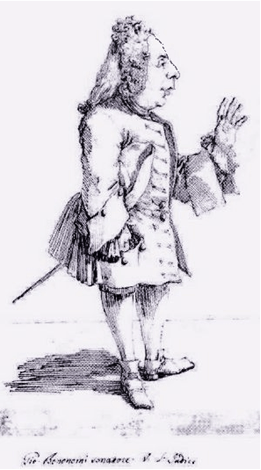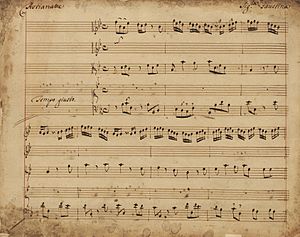Giovanni Bononcini facts for kids
Giovanni Bononcini (born July 18, 1670 – died July 9, 1747) was an Italian Baroque composer. He was also a talented cellist, singer, and teacher. Giovanni came from a family of musicians, including his father and younger brother, who were also composers.
Contents
Biography
Early Life and Music
Giovanni Bononcini was born in Modena, Italy. He was the oldest of three sons. His father, Giovanni Maria Bononcini, was a violinist and composer. Giovanni became an orphan at age eight. He studied music at the school of Giovanni Paolo Colonna in Bologna.
By the age of 15, in 1685, Giovanni had already published three collections of instrumental music. He became a member of the important Accademia Filarmonica di Bologna in 1686. He worked as a string player and singer at San Petronio. He also wrote two oratorios, which are like musical plays based on religious stories. From 1687 to 1691, he was a music director at the church of San Giovanni in Monte in Bologna. He composed a set of masses, which are musical pieces for church services.
Moving to Rome

In 1691, Bononcini moved to Rome. There, he worked for Filippo II Colonna, a powerful supporter of the arts. With Colonna's writer, Silvio Stampiglia, Bononcini created many works. These included six serenatas (short musical pieces for special events), an oratorio, and several operas. One of his most successful operas was Xerse (1694).
Another popular opera, Il trionfo di Camilla, was performed in Naples around 1696. Between 1695 and 1696, Bononcini joined two important artistic groups in Rome. These were the musical Accademia Nazionale di Santa Cecilia and the literary Accademia degli Arcadi.
Vienna and Berlin
After 1697, Bononcini left Rome and went to Vienna. He worked for Emperor Leopold I and became a favorite composer of the next emperor, Joseph. In 1702, he moved to Berlin to work for Queen Sophia Charlotte. He became her favorite composer and became even more famous. He produced new operas there, including Polifemo.
By 1710, his opera Camilla was very popular. It was performed in London and many cities across Italy. People loved its new and exciting melodies. During this time, Bononcini married Margherita Balletti, who came from a family of actors.
Time in London
From 1720 to 1732, Bononcini lived in London. For a while, he was as popular as George Frideric Handel, another famous composer. Some people supported Handel, while others preferred Bononcini. Their friendly competition inspired a famous saying, "Tweedledum and Tweedledee".
Handel eventually became more popular. Bononcini then received support from the Duchess of Marlborough. Bononcini left London after it was found that he had presented a piece of music by another composer, Antonio Lotti, as his own.
Later Years
After leaving London in 1733, Bononcini traveled to France. He gave concerts of his religious music in Paris. Then he went to Lisbon, Portugal, to teach cello to the king. In 1736, he returned to Vienna. His opera Alessandro in Sidone and his oratorio Ezechia were performed there.
By 1742, Bononcini was having money problems. He asked Maria Theresa of Austria for help. She gave him a monthly payment because of his past service. Giovanni Bononcini died on July 9, 1747, in Vienna. He was not well-known or wealthy at the time of his death. After he died, his last major work, a Te Deum, was performed to celebrate a peace treaty.
Compositions
Giovanni Bononcini wrote many different types of music. His earliest works for the cello were two Sinfonie. He also composed many operas, masses (music for church services), and a funeral song for the Duke of Marlborough.
One of his operas, Xerse, included a famous song called "Ombra mai fu". This song was so popular that another composer, Handel, later used it in his own version of Xerse. Bononcini's song Vado ben spesso cangiando loco was even used by the famous composer Franz Liszt in one of his piano pieces.
Operas
- Eraclea pasticcio (1692)
- Xerse (1694)
- Tullo Ostillio (1694)
- Muzio Scevola (1695)
- Il trionfo di Camilla (1696)
- L'amore eroica fra pastori (1696)
- La clemenza di Augusto (1697)
- La fede pubblica (1699)
- Gli affetti più grandi, vinti dal più giusto (1701)
- Cefalo (1702)
- Polifemo (1702)
- Etearco (1707)
- Turno Aricino (1707)
- Mario fuggitivo (1708)
- Abdolomino (1709)
- Caio Gracco (1710)
- Astarto (1720)
- L'odio e l'amore (1721)
- Crispo (1721)
- Griselda (1722)
- Erminia (1723)
- Calphurnia (1724)
- Astianatte (1727)
- Alessandro in Sidone (1737)
- Zenobia (1737)
Serenatas
- La nemica d'Amore (1692)
- La nemica d'Amore fatta amante (August 10, 1693)
- La costanza non gradita nel doppio amore d'Aminta (1694)
- La notte festiva (1695)
- Amore non vuol diffidenza (1695)
- Amor per amore (1696)
- L'Euleo festeggiante (1699)
- La gara delle quatri stagioni festa in musica (1699)
- Il fiore delle Eroine Trattenimento in musica (1704)
- Il ritorno di Guilio Cesare festa in musica (1704)
- La nuova gara di Giunione e Pallade festa in musica (1705)
- Endimione favola per musica (1706)
Componimenti
- Proteo sul Reno Poemetto dramattico (1703)
- Il natale di Giunone festeggiato in Samo (1708)
- Li sagrifici di Romolo per la salute di Roma (1708)
- L'arrivo della gran madre degli dei in Roma (1713)
Other Works
- XII Trattenimenti da camera op. 1 (1685)
- XII Concerti da camera op. 2 (1685)
- Sinfonias op. 3-6
- XII Duetti da camera op. 8 (1691)
- XII (Trio) Sonatas for the Chamber (1732)
- Divertimenti da camera (1722)
- Oratorio San Nicola di Bari (Rome 1693)
- Oratorio La Conversione di Maddalena (Vienna 1701)
- Oratorio Ezechia (Vienna 1737)
- 4 Messe brevi (1688)
- Te Deum in c minor (1741)
- Over 300 cantatas
See also
 In Spanish: Giovanni Bononcini para niños
In Spanish: Giovanni Bononcini para niños



